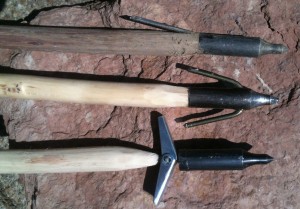-Justin Garnett, 7-9-13
Over the last few years, I have used atlatls as my near exclusive equipment for fishing. I have found a number of websites online discussing atlatls as fishing equipment, but none that describe the eccentricities of a more traditional toolkit. What do I mean by traditional toolkit? What I’m talking about is a minimal kit-one that mimics the simplicity of the atlatl and dart system itself. Traditional bow fishing was often done with long arrows and linless rigs, which I found encouraging in my attempts to slim-down my fishing kit. I decided that if possible I would like to avoid the hassle of lines and reels, since without a line there’s no line to tangle, no line to become tangled in and no reels to hold. The kit becomes less complicated and free of encumbrance the more components one can do without.
As I developed my kit, I started based on the assumption that I would be primarily going after carp-Here in the midwest we have many species of invasive asian carp. All are large, all are tasty, and all are legal to take with gigs, archery, and atlatls. Since carp are big fish, I assumed they would struggle dramatically, so I made my early fishing darts with detachable, barbed foreshafts connected to the mainshaft by a short length of cord-the idea being that on impact the mainshaft would fall away and the struggles of the fish would be mitigated by the cord connection, preventing mainshaft damage as the fish thrashed. Contrary to this expectation, I found the fish do not do a lot of thrashing when hit by atlatl darts. I soon did away with my fall-away foreshafts, in favor of glued-in foreshafts.
Although fishing points can be made primitively, I prefer to use modern points-generally archery field points with pieces of coat hanger used for barbs. I have used sections of aluminum arrows for foreshafts, which allows use of threaded field points. It’s easy to wind coat hanger wire around the threads to make barbs which are removable in the same manner as commercial fieldpoints. The most common points I use, however, are simply pieces of coat hanger wire stuck underneath a glue-on field point. These protrude behind the point making very serviceable barbs. Additionally I am currently experimenting with drilling holes through field points and inserting wire into them to produce double barbed glue-on tips. These make good looking points that are easy to switch out if damaged. However these latter two types of points have fixed barbs and as such the darts must be pushed all the way through fish to remove.

Three homemade fishing points, of increasing complexity from top to bottom. Top: Hanger barb lued under field point. Middle: Double coat hanger barb inserted through field point. Bottom: spring-loaded toggling barbs behind field point.
As with modern bow fishing arrows, fletching is really optional on fishing darts, although adding fletching will improve performance at longer distances. I have used many darts for fishing, both fletched and unfletched, and although in principle and practice I enjoy the simplicity of an unfletched dart, I often fletch anyway, since I am a creature of habit and for some reason unfletched darts look “unfinished” to some strange and obsessive part of my mind. When I do fletch, I use giant canada goose feathers, since they seem to be stiffer and more waterproof than turkey.
Most of the darts I’ve used have been of Basketmaker dimensions. Generally about 5’5 in length, and between 1.5 and 2 ounces in weight. This may seem light, but such darts carry plenty of momentum to quickly put down a carp or medium sized gar. That extra momentum from the larger projectile seems to shock the fish, rendering them senseless and less prone to thrashing and struggling as when hit by archery arrows. This has been the experience of others I have talked to as well-darts, even small darts, take the fight right out of fish.
Although generally I am a fan of willow as an atlatl dart mainshaft material, for fishing it’s far from ideal. The wood absorbs water quickly, lowering dart spine, and in drying it tends to kink up, losing it’s straightness. On the other hand, canes such as riverane (Arundinaria gigantea) and giant reed (Arundo donax) serve wonderfully in this context. These canes have waterproof skins, and hold their straightness and maintain their spine when wet.
When fishing with a lineless kit, I like to do so from the bank or while wading in shallow water. That way I’m close to the fish, and when I get a hit I can grab hold of the dart shaft easily to pull my catch in. I like to throw at fish no further away than 15 feet or so. Occasionally in current a fish will be pulled downstream, slowly struggling in the water with the dart sticking out. A crookneck staff or other similar tool is useful in this context, to allow you to reach down from banks to pull the dart shaft over toward you to bring in the fish. Otherwise, wading into the water to retrieve the fish and dart are a good option.
So with a small, light, simple kit it’s possible to take large fish easily, enjoyably, and efficiently. I enjoy few things more than having a nice day out on the water, darting carp and gar. It’s a great way to explore the past, and get insight into the more experiential aspects of atlatling as a subsistence strategy, as well as expand ones own understanding of the human condition. All in all a good time which I hope you can enjoy!



